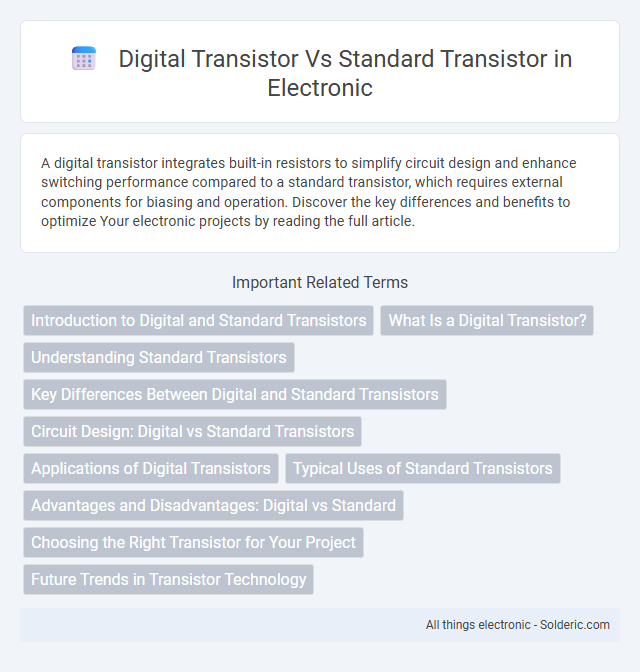A digital transistor integrates built-in resistors to simplify circuit design and enhance switching performance compared to a standard transistor, which requires external components for biasing and operation. Discover the key differences and benefits to optimize Your electronic projects by reading the full article.
Comparison Table
| Feature | Digital Transistor | Standard Transistor |
|---|---|---|
| Definition | Transistor with built-in resistors for direct interfacing with logic circuits | Basic transistor without internal resistors |
| Internal Resistors | Integrated base resistors | None, external resistors needed |
| Application | Direct switching from microcontroller or digital circuit | Amplification and switching, requires external components |
| Complexity | Lower, easier circuit design | Higher, needs additional circuit elements |
| Cost | Slightly higher due to integration | Lower, simpler device |
| Example Use Case | Signal switching in microcontroller circuits | General amplification and switching tasks |
Introduction to Digital and Standard Transistors
Digital transistors integrate resistors directly into the transistor package, simplifying circuit design and reducing component count compared to standard transistors, which require external resistors for biasing. Standard transistors offer greater flexibility in circuit configurations, making them suitable for custom applications where precise control over current and voltage is needed. Your choice between digital and standard transistors depends on the specific requirements for ease of use versus design customization in electronic projects.
What Is a Digital Transistor?
A digital transistor integrates a built-in base resistor, allowing it to switch directly with digital signals without external resistors, enhancing circuit simplicity and reliability. Unlike a standard transistor, which requires separate base resistor calculations and connections, digital transistors streamline design in logic-level applications and switching circuits. This integration optimizes performance in microcontroller interfaces and reduces component count on printed circuit boards (PCBs).
Understanding Standard Transistors
Standard transistors, such as bipolar junction transistors (BJTs) and field-effect transistors (FETs), require external resistors for biasing and current control, which impacts circuit complexity and design flexibility. They provide versatile analog and switching functionality with variable gain and input impedance characteristics tailored to specific applications. Understanding their operating regions--cutoff, active, and saturation--is crucial for designing efficient and reliable transistor-based circuits.
Key Differences Between Digital and Standard Transistors
Digital transistors integrate resistors within the transistor package to simplify circuit design by eliminating the need for external biasing components, while standard transistors require external resistors for biasing. Digital transistors provide easier interfacing with digital circuits due to built-in resistors, offering improved convenience and faster switching, whereas standard transistors offer more flexibility in customizing circuit parameters. Your choice between the two depends on application requirements, where digital transistors excel in compact digital systems and standard transistors suit analog or adjustable biasing scenarios.
Circuit Design: Digital vs Standard Transistors
Digital transistors integrate resistors directly into the transistor package, simplifying circuit design by eliminating the need for external base resistors and reducing component count. Standard transistors require additional external components for biasing and current limiting, which increases circuit complexity and design time. Your choice between digital and standard transistors impacts the overall layout, assembly efficiency, and reliability of the electronic circuit.
Applications of Digital Transistors
Digital transistors are widely used in applications requiring simplified circuit design and integrated base resistors, such as switching regulators, signal processing, and microcontroller interfacing. Their built-in resistors enable easy implementation in LED drivers, relay drivers, and logic level shifters without needing external components. These transistors provide reliable and compact solutions for low-power switching and amplification tasks in consumer electronics and embedded systems.
Typical Uses of Standard Transistors
Standard transistors are widely used in analog circuits for amplification, switching, and signal modulation across various electronic devices. They serve as essential components in audio amplifiers, voltage regulation circuits, and oscillators due to their versatility and precise control over current flow. These transistors provide customizable gain and operate efficiently in continuous signal processing tasks, making them indispensable in traditional and complex electronic systems.
Advantages and Disadvantages: Digital vs Standard
Digital transistors integrate built-in resistors for base current limiting, simplifying circuit design and enhancing reliability compared to standard transistors that require external components. You benefit from faster switching speeds and reduced component count with digital transistors, but they offer less flexibility in customizing gain and biasing than standard transistors. However, standard transistors provide broader application versatility and better heat dissipation, making them suitable for high-power or precision analog circuits.
Choosing the Right Transistor for Your Project
Selecting the right transistor depends on the application requirements, with digital transistors offering integrated resistors that simplify circuit design and reduce component count, ideal for signal switching and digital applications. Standard transistors provide greater flexibility in biasing and are preferred in analog circuits where precise control over current and gain is necessary. Understanding the specific needs of your project, such as switching speed, load characteristics, and power handling, enables the optimal choice between digital and standard transistors for reliable performance.
Future Trends in Transistor Technology
Digital transistors integrate built-in resistors, simplifying circuit design and improving reliability compared to standard transistors, which require external components for biasing. Future trends emphasize miniaturization, enhanced switching speeds, and lower power consumption, driven by advancements in semiconductor materials like gallium nitride and silicon carbide. Your projects will benefit from digital transistors as these innovations promote greater efficiency and scalability in electronic devices.
Digital transistor vs Standard transistor Infographic

 solderic.com
solderic.com